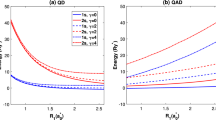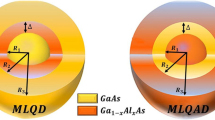Abstract
In this work, a GaAs wedge-shaped quantum dot (WSQD) is considered. In the first step, we theoretically investigated the magnetocaloric effect, magnetic susceptibility and heat capacity of WSQD without considering impurity. In the next step, we calculated the binding energy and optical properties of the WSQD under various factors, such as impurity position, temperature and pressure. For our results, we first solved the Schrödinger equation to determine the energy levels and eigenstates of the system. Then, the influence of impurity position, temperature and pressure on optical absorption coefficients (ACs) and refractive index changes (RICs) were investigated. The temperature dependence of the magnetic entropy changes (magnetocaloric effect) shows a pronounced minimum at low temperatures. The magnetic susceptibility shows both positive (paramagnetism) and negative values (diamagnetism) for different parameters. The impurity position has a key role in the electronic properties, ACs and RIs of a WSQD. The ACs and RICs enhance and shift towards lower energies under pressure. Also, the optical properties reduce in the presence of impurity.
















Similar content being viewed by others
References
S Bandyopadhyay, Physics of nanostructured solid state devices (Springer, Boston, MA, 2012)
D Awschalom, D Loss and N Samarth, Semiconductor spintronics and quantum computation (Springer, Berlin, Heidelberg, 2002)
I Zutic, J Fabian and S Das Sarma, Rev. Mod. Phys. 76, 323 (2004)
G A Prinz, Science 282, 1660 (1998)
M A Reed, Science 268, 118 (1993)
S Ünlü, I Karabulut and H Safak, Physica E 33, 319 (2006)
N Kirstaedter, O G Schmidt, N N Ledentsov, D Bimberg, V M Ustinov, A Yu Egorov and A E Zhukov, Appl. Phys. Lett. 69, 1226 (1996)
R Khordad, Int. J. Mod. Phys. B 31, 1750055 (2017)
A Sayari, M Servatkhah and R Pourmand, Physica B 628, 413631 (2022)
S A-B Nasrallah, N Sfina and M Said, Eur. Phys. J. B 47, 167 (2005)
J A R Esqueda, C I Mendoza, M del C Mussot and G J Vazquez, Physica E 28, 365 (2005)
R Khordad, C O Edet and A N Ikot, Int. J. Mod. Phys. C 33, 2250106 (2022)
F Durante, P Alves, G Karunasiri, N Hanson, M Byloos, H C Liu, A Bezinger and M Buchanan, Infrared Phys. Technol. 50, 18 (2007)
W Xiao and J L Xiao, Pramana – J. Phys. 81, 865 (2013)
H R Rastegar Sedehi, J. Low Temp. Phys. 207, 241 (2022)
R Khordad and B Mirhosseini, Pramana – J. Phys. 85, 723 (2015)
M Khosravi, B Vaseghi, K Abbasi and G Rezaei, J. Supercond. Nov. Magn. 33, 761 (2020)
M Elsaid, M Ali and A Shaer, Mod. Phys. Lett. B 33, 1950422 (2019)
R Khordad and H Bahramiyan, Pramana – J. Phys. 88, 50 (2017)
Z Zhao, X Li, Y Duan, C Chang and L Zhang, Opt. Quant. Electron. 54, 564 (2022)
H Bahramiyan, Opt. Mater. 75, 187 (2018)
E C Niculescu, Superlatt. Microstruct. 82, 313 (2015)
R Khordad and B Vaseghi, Chin. J. Phys. 59, 473 (2019)
K L Jahan, A Boda, I V Shankar, Ch N Raju and A Chatterjee, Sci. Rep. 8, 5037 (2018)
F Bzour, M K Elsaid and K F Ilaiwi, J. King Saud Univ. Sci. 30, 83 (2018)
Y Sun and J L Xiao, Superlatt. Microstrut. 145, 106617 (2020)
J L Xiao, Superlatt. Microstruct. 120, 459 (2018)
M Servatkhah, Opt. Quant. Electron. 52, 126 (2020)
J Li, B Wang and J Wang, Physica E 112, 109 (2019)
M Servatkhah and R Pourmand, Eur. Phys. J. Plus 135, 754 (2020)
R Khordad and H Bahramiyan, Int. J. Mod. Phys. B 28, 1450119 (2014)
B Vaseghi, G Rezaei and M Malian, Opt. Commun. 287, 241 (2013)
H Hassanabadi, H Rahimov, L Lu and C Wang, J. Lumin. 132, 1095 (2012)
W Xie, J. Lumin. 131, 943 (2011)
A M Tishin and Y I Spichkin, Magnetocaloric effect and its applications (Institute of Physics Publishing, Bristol, CRC Press, 2003)
K A Gschneidner Jr, V K Pecharsky and A O Tsokol, Rep. Prog. Phys. 68, 1479 (2005)
M Patra, S Majumdar, S Giri, G N Iles and T Chatterji, J. Appl. Phys. 107, 076101 (2010)
H R Rastegar Sedehi and R Khordad, Physica E 134, 114886 (2021)
K A Gschneidner and V K Pecharsky, Annu. Rev. Mater. Sci. 30, 387 (2000)
V Franco, J S Blázquez, J J Ipus, J Y Law, L M Moreno-Ramírez and A Conde, Prog. Mater. Sci. 93, 112 (2018)
Y Y Gong, D H Wang, Q Q Cao, E K Liu, J Liu and Y W Du, Adv. Mater. 27, 801 (2014)
B G Shen, J R Sun, F X Hu, H W Zhang and Z H Cheng, Adv. Mater. 21, 4545 (2009)
N A de Oliveira and P J von Ranke, Phys. Rep. 489, 89 (2010)
M S Reis, Phys. Lett. A 378, 918 (2014)
A M Tishin, Handbook of magnetic materials edited by K H J Buschow (North Holland, Amsterdam, 1999)
E Warburg, Ann. Phys. 13, 141 (1881)
Z Z Alisultanov, L S Paixao and M S Reis, Appl. Phys. Lett. 105, 232406 (2014)
O A Negrete, F J Peña and P Vargas, Entropy 20, 888 (2018)
D E Aspnes, Phys. Rev. B 14, 5331 (1976)
B Welber, M Cardona, C K Kim and S Rodriquez, Phys. Rev. B 12, 5729 (1975)
H Ehrenrich, J. Appl. Phys. 32, 2155 (1961)
G A Samara, Phys. Rev. B 27, 3494 (1983)
R F Kopf, M H Herman, M Lamont Schnoes, A P Perley, G Livescu and M Ohring, J. Appl. Phys. 71, 5004 (1992)
R W Boyd, Nonlinear optics (Academic Press, New York, 2003)
S Unlu, I Karabulut and H Safak, Physica E 33, 319 (2006)
D Ahn and S L Chuang, IEEE J. Quantum Elect. 23, 2196 (1987)
K J Kuhn, G U Lyengar and S Yee, J. Appl. Phys. 70, 5010 (1991)
W Xie, Physica B 403, 4319 (2008)
P Hashemi, M Servatkhah and R Pourmand, Opt. Quant. Electron. 53, 567 (2021)
Author information
Authors and Affiliations
Corresponding author
Appendix A
Appendix A
The single-particle states are given by
where \(\mathrm {\Psi }\) is the single-particle wave function and E is the energy eigenvalue. The Hamiltonian of eq. (A.1) in the cylindrical coordinates is given by
Let us present the wave function of the electron as
Inserting eq. (A.3 ) into eq. (A.2), separating variables in eq. (A.2), we shall obtain the following equations:
The solutions of eqs (A.4) and (A.5) appear as
and
where
Also, the parameters C, D and S are constants. Now, by imposing the boundary conditions on eqs (A.6) and (A.7), we can obtain eqs (8)–(10) in the main text.
Rights and permissions
About this article
Cite this article
Sayyari, A., Servatkhah, M. & Pourmand, R. Magnetocaloric effect, magnetic susceptibility, heat capacity and optical properties of wedge-shaped quantum dots. Pramana - J Phys 97, 75 (2023). https://doi.org/10.1007/s12043-023-02535-y
Received:
Revised:
Accepted:
Published:
DOI: https://doi.org/10.1007/s12043-023-02535-y




